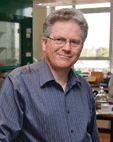DOI: 10.1039/C2CC90099H
(Profile)
Chem. Commun., 2012, 48, 4931-4932
Interview with Jeremy Sanders
| ||||||
Do you remember what it felt like to publish your first ChemComm article?
Vividly! It was my very first publication (DOI: 10.1039/c29700000422), submitted in 1970 just a few months after I started my PhD on lanthanide shift reagents with Dudley Williams. The science was magical: sprinkling a few milligrams of lanthanide complex into a solution of an organic compound transformed the NMR spectrum in a way that directly told us about molecular shape and also binding ability. That first paper generated world-wide interest, many copy-cat papers and hundreds of citations. It was an addictive experience, and it sealed my fate as an academic.How has your research evolved from your first to your most recent article?
I have ranged over many organic, inorganic, physical and biological areas, the common features usually being spectroscopy, binding and recognition. In our recent dynamic combinatorial chemistry we generate complex libraries (= mixtures) of inter-converting structures that evolve in response to stimuli. For example, templates select and amplify their best receptors; these are of unpredictable structure: we design the experiment rather than the molecule. We have recently reported extraordinary linear, macrocyclic and catenated receptors that are far too flexible and exotic to have been designed through conventional thinking. We also accidentally discovered helical supramolecular nanotubes that solubilise C60 and other guests.What do you like most about publishing in ChemComm?
It's quick, highly visible and a convenient length—except for our recent very big molecules. Most of the earlier significant advances I've been lucky enough to publish made their first appearance in ChemComm (in 1970, 1980, 1987, 1989, 1993, 1996, 1997, 1999,…).What aspect of your research are you most excited about at the moment?
It has always been this week's results. What was exciting last week rapidly becomes old, comfortable and familiar.What is the best part of your job?
As a chemist, helping bright but inexperienced students and postdocs to develop into independent creative scientists who then have better ideas than me and take me into areas of science I know nothing about. As a Pro-Vice-Chancellor, helping an 800-year-old institution find new and better ways of doing things.What is the secret to success in scientific publishing?
It's important to have a good scientific story to tell. Then, tell it well: have a short title, a striking opening sentence, and lots of pictures that don't need explanation. Distil the data into readily absorbed knowledge and wisdom using a simple narrative without jargon, and avoid hype.What is your advice to young emerging scientists?
It used to be pick (or create) your own area, and don't follow the crowd. That may not be so easy in these days of top-down imposed strategic targets. We should do unexpected things and look for unexpected results, because that is where the next breakthrough will come from: experiments or projects that always give the predicted result don't teach us anything new. My research career has lurched from one happy accident to another, and my group's collective talent has been to recognise and exploit that good luck. Remember that the way to make an impact is to succeed where everyone expects failure. Before lanthanide shift reagents came along, everyone “knew” that you couldn't get useful NMR spectra from paramagnetics. Several very talented people gave me excellent reasons why dynamic combinatorial chemistry couldn't work, and our 1980s NMR work on the biophysics of polymers in live cells was only successful because we didn't “know” what the experts did—and they turned out to be wrong.What do you do in your spare time?
Most evenings, I relax by cooking. It's the only practical chemistry I'm any good at.By the time I'm 100 I would like to have…
...made the world a slightly better place.| This journal is © The Royal Society of Chemistry 2012 |

